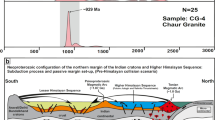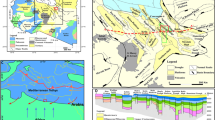Abstract
In the Garhwal Himalayan Corridor (GHC), we recorded the magnetotelluric (MT) data at 40 sites, in three phases. Out of these 40 sites, useful tipper or vertical magnetic field transfer function (VTF) data was available only at 19 sites. The resistivity model, obtained from 3D inversion of the MT data, is used to investigate the existence of transverse tectonic structures in the Garhwal Himalaya. Through a synthetic inversion experiment on scattered data over a profile, like our GHC profile, we have demonstrated that the MT data can be used to qualitatively infer about the off-profile resistivity structures within about 20 km from the profile. We carried out several 3D inversion experiments using different subsets of full impedance tensor and VTF responses individually and jointly to arrive at the final resistivity model. The 2D profile section of our 3D resistivity model explains the thrust tectonic and flat ramp flat geometry of the Main Himalayan Thrust (MHT). Furthermore, the inverted model delineated Delhi–Haridwar Ridge (DHR) as a highly resistive (> 1000 Ωm) feature beneath the low resistive (< 50 Ωm) sediments of the Indo-Gangetic Plain (IGP). The DHR continues up to the Inner Lesser Himalayan region, and it is bounded by two conductive (< 10 Ωm) fluid-saturated fractured zones situated off-profile, and these run nearly parallel to the DHR. From the electrical image of the DHR and of the associated conducting feature, which have the geoelectric strike of N13°E, we inferred that these features are transverse to the main Himalayan arc.

The map was created with gmt software version 5 (http://gmt.soest.hawaii.edu/)








adapted from Rawat et al. (2014), 100 km east of the RG profile



Similar content being viewed by others

References
Arora, B. R., & Adam, A. (1992). Anomalous directional behaviour of induction arrows above elongated conductive structures and its possible causes. Physics of the Earth and Planetary Interiors,74(3–4), 183–190.
Arora, B. R., Unsworth, M. J., & Rawat, G. (2007). Deep resistivity structure of the northwest Indian Himalaya and its tectonic implications. Geophysical Research Letters. https://doi.org/10.1029/2006GL029165.
Auden, J. B. (1935). Transverses in the Himalaya. Geological Survey of India Recruitment,69(2), 123–167.
Avdeeva, A., Moorkamp, M., Avdeev, D., Jegen, M., & Miensopust, M. (2015). Three-dimensional inversion of magnetotelluric impedance tensor data and full distortion matrix. Geophysical Journal International,202(1), 464–481.
Bansal, B. K., & Verma, M. (2012). The M 4.9 Delhi earthquake of 5 March 2012. Current Science,102(12), 1704–1708.
Byerlee, J. (1990). Friction, overpressure and fault normal compression. Geophysical Research Letters,17(12), 2109–2112.
Caldwell, W. B., Klemperer, S. L., Lawrence, J. F., & Rai, S. S. (2013). Characterizing the main Himalayan Thrust in the Garhwal Himalaya, India with receiver function CCP stacking. Earth and Planetary Science Letters,367, 15–27.
Egbert, G. D., & Kelbert, A. (2012). Computational recipes for electromagnetic inverse problems. Geophysical Journal International,189(1), 251–267.
Friedrichs, B. (2003). MAPROS: Magnetotelluric data processing software. Braunschweig: Metronix GmbH.
Gahalaut, V. K., & Arora, B. R. (2012). Segmentation of seismicity along the Himalayan Arc due to structural heterogeneities in the under-thrusting Indian plate and overriding Himalayan wedge. Episodes,35(4), 493–500.
Gahalaut, V. K., & Kundu, B. (2012). Possible influence of subducting ridges on the Himalayan arc and on the ruptures of great and major Himalayan earthquakes. Gondwana Research,21(4), 1080–1088.
Gansser, A. (1974). Himalaya (Vol. 4, pp. 267–278). London: Geological Society. (Special Publications).
Godin, L., & Harris, L. B. (2014). Tracking basement cross-strike discontinuities in the Indian crust beneath the Himalayan orogen using gravity data—relationship to upper crustal faults. Geophysical Journal International,198(1), 198–215.
Gokarn, S. G., Gupta, G., Rao, C. K., & Selvaraj, C. (2002). Electrical structure across the Indus Tsangpo suture and Shyok suture zones in NW Himalaya using magnetotelluric studies. Geophysical Research Letters,29(8), 92-1–92-4.
Gupta, G., Gokarn, S. G., & Singh, B. P. (1994). Thickness of the Siwalik sediments in the Mohand-Ramnagar region using magnetotelluric studies. Physics of the Earth and Planetary Interiors,83(3–4), 217–224.
Harris, R. A. (1998). Introduction to special section: Stress triggers, stress shadows, and implications for seismic hazard. Journal of Geophysical Research: Solid Earth,103(B10), 24347–24358.
Israil, M., Mamoriya, P., Gupta, P. K., & Varshney, S. K. (2016). Transverse tectonics feature delineated by modelling of magnetotelluric data from Garhwal Himalaya corridor India. Current Science,111(5), 868–875.
Israil, M., Tyagi, D. K., Gupta, P. K., & Niwas, S. (2008). Magnetotelluric investigations for imaging electrical structure of Garhwal Himalayan corridor, Uttarakhand India. Journal of Earth System Science,117(3), 189.
Kanaujia, J., Kumar, A., & Gupta, S. C. (2016). Three-dimensional velocity structure around Tehri region of the Garhwal Lesser Himalaya: Constraints on geometry of the underthrusting Indian plate. Geophysical Journal International,205(2), 900–914.
Khattri, K. M., & Tyagi, A. (1983a). Seismicity patterns in the Himalayan plate boundary and identification of the areas of high seismic potential. Tectonophysics,96(3–4), 281–297.
Khattri, K., & Tyagi, A. K. (1983b). The transverse tectonic features in the Himalaya. Tectonophysics,96(1–2), 19–29.
Kiyan, D., Jones, A. G., & Vozar, J. (2013). The inability of magnetotelluric off-diagonal impedance tensor elements to sense oblique conductors in three-dimensional inversion. Geophysical Journal International,196(3), 1351–1364.
Kumar, G. P., Manglik, A., & Thiagarajan, S. (2014). Crustal geoelectric structure of the Sikkim Himalaya and adjoining Gangetic foreland basin. Tectonophysics,637, 238–250.
Lemonnier, C., Marquis, G., Perrier, F., Avouac, J. P., Chitrakar, G., Kafle, B., et al. (1999). Electrical structure of the Himalaya of central Nepal: High conductivity around the mid-crustal ramp along the MHT. Geophysical Research Letters,26(21), 3261–3264.
Mahesh, P., Rai, S. S., Sivaram, K., Paul, A., Gupta, S., Sarma, R., et al. (2013). One dimensional reference velocity model and precise locations of earthquake hypocenters in the Kumaon-Garhwal Himalaya. Bulletin of the Seismological Society of America,103(1), 328–339.
Manglik, A., Kumar, G. P., & Thiagarajan, S. (2013). Transverse tectonics in the Sikkim Himalaya: A magnetotelluric study. Tectonophysics,589, 142–150.
Miglani, R., Shahrukh, M., Israil, M., Gupta, P. K., Varshney, S. K., & Elena, S. (2014). Geoelectric structure estimated from magnetotelluric data from the Uttarakhand Himalaya India. Journal of earth system science,123(8), 1907–1918.
Prasath, R. A., Paul, A., & Singh, S. (2017). Upper crustal stress and seismotectonics of the Garhwal Himalaya using small-to-moderate earthquakes: Implications to the local structures and free fluids. Journal of Asian Earth Sciences,135, 198–211.
Qureshy, M. N. (1969). Thickening of a basalt layer as a possible cause for the uplift of the Himalayas—a suggestion based on gravity data. Tectonophysics,7(2), 137–157.
Rawat, G., Arora, B. R., & Gupta, P. K. (2014). Electrical resistivity cross-section across the Garhwal Himalaya: Proxy to fluid-seismicity linkage. Tectonophysics,637, 68–79.
Sati, D., & Nautiyal, S. P. (1994). Possible role of Delhi–Haridwar subsurface ridge in generation of Uttarkashi earthquake, Garhwal Himalaya, India. Current Science,67, 39–44.
Sen, A., Kumar, A., Gupta, S. C., & Kumar, A. (2014). Spectral analysis of the earthquake sources around Roorkee (INDIA) region and its surrounding Indo-Gangetic planes. Disaster Advances,7(6), 1–11.
Shandilya, A. K., & Shandilya, A. (2016). Studies on the Seismicity in Garhwal Himalaya, India. In N. Raju (Ed.), Geostatistical and geospatial approaches for the characterization of natural resources in the environment (pp. 503–512). Cham: Springer. https://doi.org/10.1007/978-3-319-18663-4_76.
Singh, A. (2018). Development of MATLAB based 3D inversion algorithm for MT and DCR data. Thesis, Indian Institute of Technology, Roorkee, India.
Singh, A., Dehiya, R., Gupta, P. K., & Israil, M. (2017). A MATLAB based 3D modeling and inversion code for MT data. Computers & Geosciences,104, 1–11.
Siripunvaraporn, W., Egbert, G., & Uyeshima, M. (2005). Interpretation of two-dimensional magnetotelluric profile data with three-dimensional inversion: Synthetic examples. Geophysical Journal International,160(3), 804–814.
Smirnov, M. Y. (2003). Magnetotelluric data processing with a robust statistical procedure having a high breakdown point. Geophysical Journal International,152(1), 1–7.
Spratt, J. E., Jones, A. G., Nelson, K. D., Unsworth, M. J., & INDEPTH MT Team. (2005). Crustal structure of the India-Asia collision zone, southern Tibet, from INDEPTH MT investigations. Physics of the Earth and Planetary Interiors,150(1–3), 227–237.
Thakur, V. C., & Rawat, B. S. (1992). Geological map of the western Himalaya 1:1,200,000. Oxford: Pergamon Press.
Tietze, K., Ritter, O., & Egbert, G. D. (2015). 3-D joint inversion of the magnetotelluric phase tensor and vertical magnetic transfer functions. Geophysical Journal International,203(2), 1128–1148.
Unsworth, M. (2010). Magnetotelluric studies of active continent–continent collisions. Surveys In Geophysics,31(2), 137–161.
Unsworth, M. J., Jones, A. G., Wei, W., Marquis, G., Gokarn, S. G., Spratt, J. E., et al. (2005). Crustal rheology of the Himalaya and Southern Tibet inferred from magnetotelluric data. Nature,438(7064), 78.
Valdiya, K. S. (1976). Himalayan transverse faults and folds and their parallelism with subsurface structures of north Indian plains. Tectonophysics,32(3–4), 353–386.
Valdiya, K. S. (1980). Geology of the Kumaon Lesser Himalaya. Dehra Dun: Wadia Institute of Himalaya.
Varentsov, I. M. (2007). Joint robust inversion of magnetotelluric and magnetovariational data. Methods in Geochemistry and Geophysics,40, 185–218.
Varentsov, I. M., & Sokolova, E. Y. (2005). The magnetic control approach for the reliable estimation of transfer functions in the EMTESZ Pomerania project. Publications of the Institute of Geophysics, Polish Academy of Sciences,95(386), 68–79.
Varentsov, I. M., Sokolova, E. Y., Martanus, E. R., & Nalivaiko, K. V. (2003). System of electromagnetic field transfer operators for the BEAR array of simultaneous soundings: Methods and results. Izvestiya Physics of the Solid Earth,39(2), 118–148.
Wason, H. R., Kumar, J., & Walia, S. K. (1999). Local seismicity of the Garhwal Himalaya subsequent to the Uttarkashi earthquake of October 20, 1991. Gondwana Research Group Memoir,6, 335–340.
Yu, G., Khattri, K. N., Anderson, J. G., Brune, J. N., & Zeng, Y. (1995). Strong ground motion from the Uttarkashi, Himalaya, India, earthquake: Comparison of observations with synthetics using the composite source model. Bulletin of the Seismological Society of America,85(1), 31–50.
Acknowledgements
The authors are thankful to the Ministry of Earth Sciences, Govt. of India (grant no. MES-731-ESD) for financial support. The authors are also thankful to Prof. Gary Egbert and Anna Kelbert for providing us the ModEM code. We also thank Dr. Gautam Rawat for providing us their model in digital format and Prof. Ramesh Chandar for sparing his time in careful reading of the final form of the paper. We thank the reviewers of the paper for constructive comments and suggestions which helped us to improve the quality of the paper.
Author information
Authors and Affiliations
Corresponding author
Additional information
Publisher's Note
Springer Nature remains neutral with regard to jurisdictional claims in published maps and institutional affiliations.
Rights and permissions
About this article
Cite this article
Devi, A., Israil, M., Gupta, P.K. et al. Transverse Tectonics Structures in the Garhwal Himalaya Corridor Inferred from 3D Inversion of Magnetotelluric Profile Data. Pure Appl. Geophys. 176, 4921–4940 (2019). https://doi.org/10.1007/s00024-019-02222-3
Received:
Revised:
Accepted:
Published:
Issue Date:
DOI: https://doi.org/10.1007/s00024-019-02222-3



